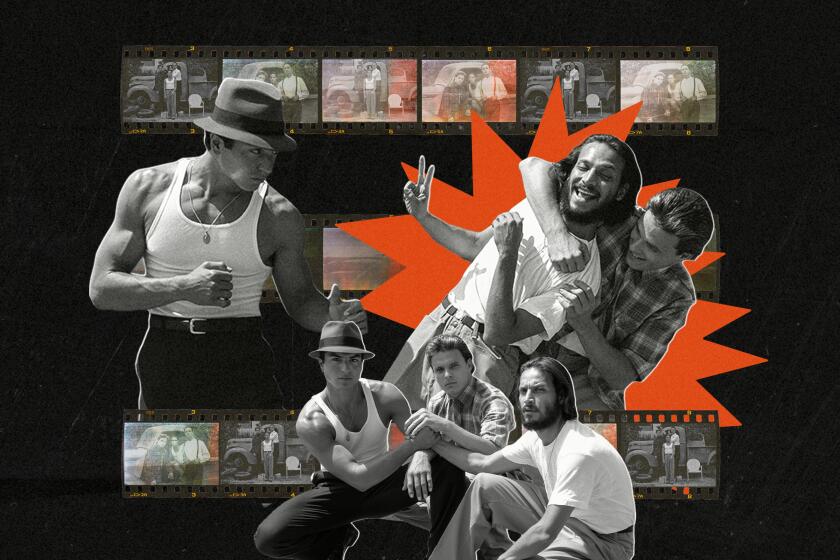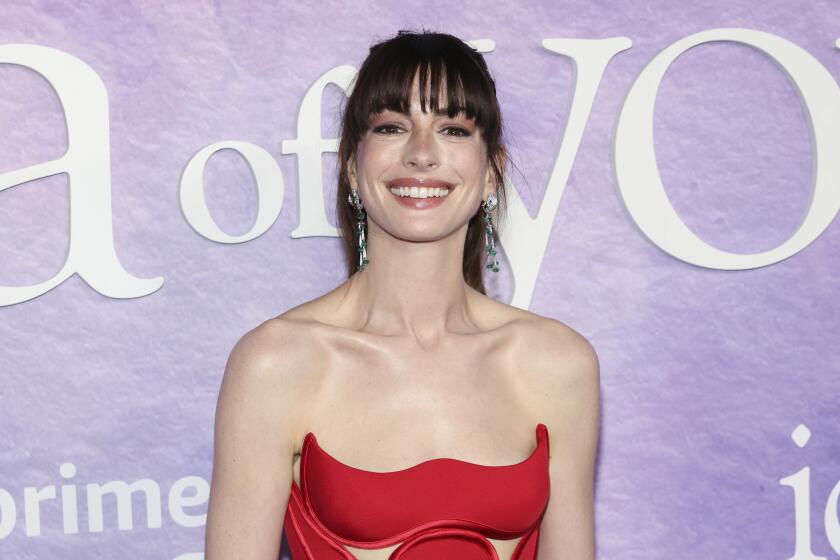‘Green Hornet’s’ Michel Gondry dreaming big in Hollywood
In the magical realm of writer-director Michel Gondry’s films, characters defy common sense and dream the impossible dream — sometimes literally — as a matter of course.
In his 2006 surrealist dramedy “The Science of Sleep,” Gondry conjured a lo-fi version of the nocturnal subconscious from papier-mâché, bad horse costumes and stop-motion animation. And in the filmmaker’s 2004 romantic drama “Eternal Sunshine of the Spotless Mind” (for which Gondry shares a best original screenplay Oscar), Jim Carrey and Kate Winslet’s characters don futuristic hair-dryer helmets to erase all the memories they have of each other (en route to falling in love all over again).
Gondry’s films can seem magnificently heartfelt and handmade, if not particularly realistic. Ergo, certain words crop up again and again in reviews of his work: “charming” and “idiosyncratic,” “quirky” and “naive” — but notably, never “aggressively commercial” or even “mainstream.”
Which is why the French music video ace wasn’t a no-brainer choice to direct “The Green Hornet,” Columbia Pictures’ $130-million 3-D superhero comedy starring Seth Rogen and Cameron Diaz that arrives in theaters Friday. It’s an adaptation of the ‘60s television show (and ‘30s radio serial) of the same name that’s full of shoot’em-ups, kung fu beat-downs, FX-enhanced car chases and unmitigated bromance.
“Hornet” is Gondry’s first studio movie, his first stab at making what he terms in heavily accented Franglais “popular cinema” and the only film he’s directed on which he did not retain final cut.
“If they asked me [to direct ‘Hornet’], it’s because I’m going to bring something to the project,” Gondry said, seated backstage at “Jimmy Kimmel Live!” where he was in the midst of guest directing an episode. “They wanted to make something different. At the same time, I knew they would not let me do a movie that did not speak to the audience. We have to fulfill the expectations of this kind of budget.”
It raises the question: Does Gondry, 47, feel the same sense of ownership he’s felt on his other films?
He acknowledged being deeply beholden to Rogen, who in addition to playing the lead in “Hornet” produced and co-wrote the film. “Seth was as important, if not more important than the studio,” Gondry said. “So I felt, ‘Well, it’s not really my movie.’ I accepted that. But I realized there was still tons I could infiltrate or infuse my personality through discussion all the time.”
Co-written and executive produced by Evan Goldberg, “The Green Hornet” centers on Britt Reid (the newly svelte Rogen), the moneyed, party-hearty scion of a stern newspaper magnate. When his dad dies under mysterious circumstances, Britt must take command of a media empire he’s unequipped to deal with, also inheriting Reid senior’s manservant, Kato (Taiwanese pop star and action movie heartthrob Jay Chou), a cool contraption-making macher who also happens to be a butt-kicking kung fu expert.
Faced with a sudden existential crisis, the two join together as masked crusaders, combating the forces of evil in urban Los Angeles by posing as evildoers themselves while tooling around in a ‘60s Chrysler Imperial outfitted with nifty rocket launchers, machine guns and a vintage turntable.
It’s all a far cry from Gondry’s last movie, “ Be Kind Rewind,” in which bumbling characters played by Jack Black and Mos Def accidentally erase a video store’s inventory and try to re-shoot a library of movies — “Ghostbusters,” “Driving Miss Daisy” — using a camcorder and cardboard. But in a twist of kismet, Gondry set out to make “Hornet” as his debut feature way back in 1997, before the project was shelved by its then-distributor Universal.
“My ambition was to come to Hollywood and do a Hollywood movie,” Gondry explained.
“Hornet” went through a pre-production do-si-do with other directors including Stephen Chow (“Kung Fu Hustle”) and Kevin Smith ( “Zack and Miri Make a Porno”) and bounced between Universal and Miramax before winding up at Columbia in 2007. According to “Hornet” producer Neal Moritz, Columbia’s parent company, Sony Pictures, wasn’t exactly champing at the bit to hand Gondry the reins.
“When I told the studio [about Michel], they looked at me like I was crazy,” Moritz recalled. “I said, ‘I’ll put my reputation on the line for it.’”
Gondry’s placement in the “Hornet” nest fits into a relatively recent strategy by various studios, in which art-house auteurs are handed big-budget event films in an effort to marry artistic credibility and mass appeal. Christopher Nolan is the poster boy for this sort of thing — he was best known for brooding, arty fare like 2000’s “Memento” before landing the gig to resurrect Warner Bros.’ “Batman” film franchise — a feat he capably accomplished to the tune of a combined $1.37 billion in box office in just two movies, “Batman Begins” and “The Dark Knight.” (Nolan and Gondry share the same longtime agent, Dan Aloni.)
Warner Bros. similarly entrusted Spike Jonze (“Being John Malkovich,” “Adaptation”) to make a family-friendly $80-million adaptation of the epochal children’s book “ Where the Wild Things Are.” Paramount tapped “Much Ado About Nothing” director Kenneth Branagh to film an adaptation of Marvel comics’ “Thor.” And Sony has enlisted Marc Webb — a music video hot-shot whose lone feature film is the quirky anti-romance “(500) Days of Summer” — to revive its “Spider-Man” franchise.
Still, Rogen surmises the director’s hiring differently: “He story-boarded some action sequences, amazing stuff that was very visually impressive. But what sold us was, he just seemed to understand the tone we were going for and the characters we wanted to make.”
Gondry arrived fully prepared to collaborate. But to hear him and Moritz tell it, “The Green Hornet” came with no shortage of creative compromises and consensus filmmaking with from-the-top-down management quite unlike anything the French filmmaker had experienced.
“Myself, Michel and Seth or Evan would disagree,” Moritz said, “and whichever side had two out of three votes would win.”
Added Gondry: “It’s interesting, this phenomenon. When you have final cut, people don’t confront you so directly. When they don’t like it, they don’t tell you. You only find out when it’s too late. When you work with a big studio, they tell you right away when they don’t like it.”
Gondry’s signature visual innovations do help elevate the material. In “Hornet’s” fight sequences, the director developed “Kato-vision” — a space and time distortion technique in which every combatant on-screen appears to be throwing punches at different speeds. In a sequence that establishes Kato’s martial arts bona fides, the director illustrated the character’s cat-like speed via decidedly low-tech methods, having Chou bound across four sets of identical cars parked side by side rather than rely on digital trickery.
Nevertheless, Rogen said a certain “language barrier” resulted in him and Goldberg superseding Gondry’s directorial authority. The two went into the editing bay after the filmmaker had submitted a version of the film to make their own revisions.
“We have a very specific joke style based on awed, semantical references,” said Rogen. “There were times when Gondry didn’t understand the jokes we were going for. We had to ask him if we could go in the editing room and spend some time looking for jokes that he didn’t recognize as jokes at all. He was cool with it. It made the movie funnier.”
Said Gondry: “It was back and forth. Sometimes they would be the chief and sometimes I would be the chief.”
No matter what compromises he made, the filmmaker said he feels gratified at the end result and shares a sense of pride with his collaborators. He knows “Hornet” could be a game-changer for his standing in Hollywood.
“At the end of the day, we did this movie and we feel awesome about it,” Gondry said. “We’re adult enough to see that we went down this road and only what matters is on the screen. I don’t think it’s selling my soul to make a commercial movie.”
Times staff writer Ben Fritz contributed to this report.
More to Read
Only good movies
Get the Indie Focus newsletter, Mark Olsen's weekly guide to the world of cinema.
You may occasionally receive promotional content from the Los Angeles Times.







